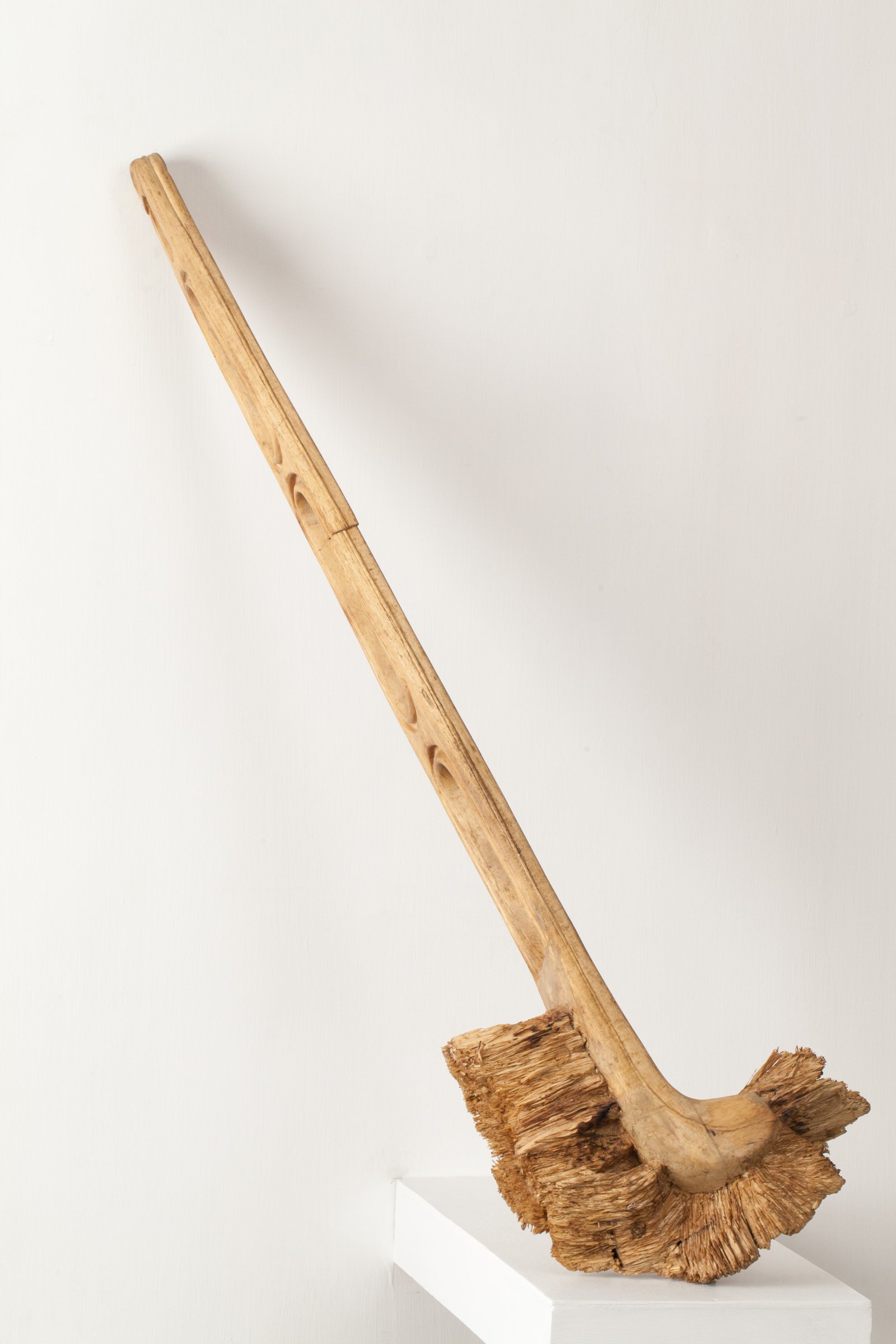
Metamorphosis by Debanjan Roy
May 5 - May 23, 2015 at Akar Prakar, Delhi
Metamorphosis presupposes both change and continuity, while change presupposes its own opposite, sameness.
The structural sameness inherent in Roy's wood carvings ensure a continuity of form. The transformation lies in the materiality of the changed object, the renunciation of plastic or steel or the electronic in favour of the organic-ness of biodegradable wood. Roy infuses his found objects with life, thus presenting us with the predicament of their portended immortality against the dilemma of all that can be carbon-dated. Cast against sun-like light, suspended against the otherwise blank white-cube walls, the wooden carvings of derelict, once-functional objects are endowed with shadows that contort according to their form. They are now isolated figures within a solitary landscape, their lifelessness animated against the backdrop of their inutility.
They embody a capsulated meditation on time; simultaneously reflecting the expired shelf-lives of the objects upon which they are modelled while showcasing their new destinies as objects of art and therefore, subjects of time. Roy makes a spectacle out of ruin. Through his magnified recreations he offers these abandoned objects the redemption of restoration. He reinstates them into the fragile memory of the uncollected unconscious and in doing so, resists the proclivity towards sermonising. His is not so much a commentary on contemporary practices of consumption as much as it is an intervention. What the opacity of his material conceals is the invisible hand of the artist and all its curative possibilities in an age that is so obsessed with ingenuity, it is compelled to discard of the new the instant it loses its technological newness and is replaced by the hyper new; case in point the wooden imitation of an analog camera, which has been almost universally been replaced by the digital; or his derelict, time-worn tea strainer that is no longer whole enough to filter liquid and restrain pellets of tea powder from flowing into a mug. Roy posits himself as a mediator within this graveyard of used goods. His impulse is not to canonise as much as to expose the wounds inflicted upon objects across their lifespan. The wire gravitating towards the floor in his hair clipper piece serves as a metaphor for the already dated. The cord connecting the technological object to a power source is already in obsolescence.
Finally, how relevant is art within the context of these constant advancements? What succour does it offer to the disenfranchised or the marginalised? Roy's carvings and drawings are essentially embedded in these provocations. If all art is inherently useless, of what use is it?
~ Rosalyn Dmello
Debanjan Roy | Comb | Wood | 44 x 9 x 2 in | 2014
Debanjan Roy | Doll | Wood | 59 x 14 x 17 in | 2014
Debanjan Roy | Fish chopping stick | Wood | 12.5 x 2.5 x 2.5 in | 2014
Debanjan Roy | Garbage bag | Wood | 11 x 16 15 in | 2014
Debanjan Roy | Wafer Packets | Wood | 2014
Debanjan Roy | Toilet brush | Wood | 35 x 10 x 3 in | 2014
Debanjan Roy | Tea Strainer | Wood | 34 x 14 x 3 in | 2014
Debanjan Roy | Saline bottle | Wood | 65 x 7 x 5 in | 2014
Debanjan Roy | Refrigerator | Wood | 43 x 22 x 9 in | 2014
Debanjan Roy | Refrigerator | Wood | 43 x 22 x 9 in | 2014
Debanjan Roy | Plastic Glass | Wood | 34 x 11 x 11 in | 2014
Debanjan Roy | Mosquito Repellent | Wood | 15 x 11 x 12 in | 2014
Debanjan Roy | Large Bottle | Wood | 31 x 9 x 9 in | 2014
Debanjan Roy
Debanjan Roy (b. 1975) completed his Bachelor of Arts in Visual Arts (Sculpture) from Rabindra Bharati University, Kolkata, in 1998, and Masters in Visual Arts (Sculpture) from Rabindra Bharati University, Kolkata, in 2000. In 2016, he was also the artist in residence at the Château De La Napoule, Nice, under the Asiatic Museum, Nice, France, in collaboration with Akar Prakar, India.
Some of his recent solo shows include Toying with Gandhi, Akar Prakar, 2021 & 2019; Metamorphosis, Akar Prakar, New Delhi and France, 2015; Waste Side Story, Akar Prakar, Kolkata, 2014; The Altar of Convenience, Aicon Gallery, New York, 2013; Looking for Bapu, Akar Prakar, Ahmedabad and Kolkata, 2010.
Debanjan has participated in several group shows including Multitudes & Assemblages for Hub India at Accademia Albertina di Belle Arti, Turin, Italy, 2022; Sightings: Out of the wild, KNMA Noida, 2019; Seattle Art Museum, USA; Bangladesh Art Biennale, Dhaka, 2013; Vermont Studio Centre Residency Open Studio show, Johnson, USA, 2011 and 2012; Enduring Legacy, Berlin and Munich, Germany; Reprise Aicon Gallery, London; and Who has seen Mr. Gandhi? at Tangerine, Bangalore, 2010, to name a few. He has been awarded the Navonmesha Puraskar by Lath Sarvodaya Trust, Kolkata 2005; Nirman Art Award, Kolkata, 2004; Lalit Kala Akademi Scholarship, New Delhi 2002; Junior Fellowship, Ministry of Tourism and Culture, Govt. of India, among other honours. The artist lives and works in Kolkata, India.












